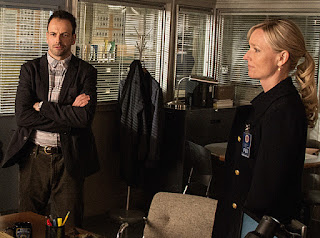 |
| Jonny Lee Miller and Kari Matchett in Elementary |
Howard Ennis (Terry Kinney) is a serial killer who has killed several women. He was caught based on the work of Kathryn Drummond (Kari Matchett), professional profiler.
Eight years after he has been imprisoned, Howard is released temporarily to perform a kidney donation for his sick sister, Patricia Ennis (Jessica Hecht). Howard escapes from the scene of operation after killing everyone around him.
NYPD calls in Kathryn again to apprehend Howard. Holmes is also involved in the investigation and he openly resents Kathryn’s efforts.
Watson does some research and finds out that Kathryn had published Holmes’ profile in an article termed “The Deductionist”. Holmes lets Watson know that he was intimately involved with Kathryn and tried to teach her the methods of observation and deduction.
Click on the link below to buy your copy of Season 1:
Kathryn did not explicitly name the
subject of her article but Holmes is still ruffled at some of the points made.
Kathryn predicted that Holmes is destined to destroy himself.
Holmes does not believe in Kathryn’s abilities. Patricia on the other hand, does have faith in Kathryn and believes she is the one person who can stop Howard.
Like Holmes, Howard Ennis too holds a personal long grudge towards Kathryn. He blames Kathryn for the deaths of his parents.
Going into more details will be spoiling the mystery. The mystery component is pretty good and rivals that of Episode # 3 (Child Predator) for being one of the best the show has offered so far.
Holmes does not believe in Kathryn’s abilities. Patricia on the other hand, does have faith in Kathryn and believes she is the one person who can stop Howard.
Like Holmes, Howard Ennis too holds a personal long grudge towards Kathryn. He blames Kathryn for the deaths of his parents.
Going into more details will be spoiling the mystery. The mystery component is pretty good and rivals that of Episode # 3 (Child Predator) for being one of the best the show has offered so far.
 |
| Jonny Lee Miller and Lucy Liu as Sherlock Holmes and Joan Watson |
Canonical References:
Kari Matchett as Kathryn Drummond
5. Miller’s Holmes displays
some knowledge of astronomy – Watson mentions that Sherlock Holmes has nil
knowledge in Astronomy in A Study in Scarlet. This is an indirect
reference to the number of inconsistencies in the Canon. One example is the
shifting nature of Watson’s war injury.
The Canonical Holmes’ sense of humor is
one of my favorite Sherlockian traits. I enjoyed the comedic touches that
Miller brought to his performance in this episode. I especially liked his
reference to Kathryn’s profession as “pseudoscience”.
Lucy Liu’s Watson also gets to shine in
her storyline. She applies her client’s methods and is able to resolve her
problem with her landlord to her advantage. Her medical knowledge comes in
handy too in the investigation.
Terry Kinney is effective as the serial
killer. Terry successfully portrays an individual who is quite creepy and
cunning at the same time.
Kari Matchett as Kathryn Drummond
|
The Canonical Holmes’ sense of humor is one of my favorite Sherlockian traits. I enjoyed the comedic touches that Miller brought to his performance in this episode. I especially liked his reference to Kathryn’s profession as “pseudoscience”.
Lucy Liu’s Watson also gets to shine in her storyline. She applies her client’s methods and is able to resolve her problem with her landlord to her advantage. Her medical knowledge comes in handy too in the investigation.
Terry Kinney is effective as the serial killer. Terry successfully portrays an individual who is quite creepy and cunning at the same time.
 |
| Terry Kinney as Howard Ennis |
A good episode and hope they continue
to become even better in the future.
Click here to read all my posts about CBS Elementary.
If you enjoyed this post, please subscribe to this blog by clicking here.
Image Source: CBS
Click here to read all my posts about CBS Elementary.
If you enjoyed this post, please subscribe to this blog by clicking here.
Image Source: CBS
You might also like:
 |
| Elementary Episode # 13 - "The Red Team" |
 |
| Sherlock |



























